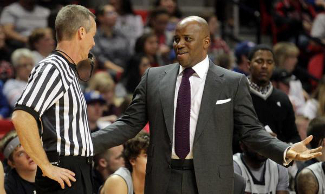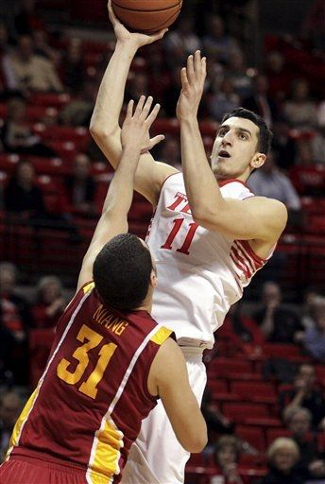Erwin Center | Austin, TX | Tip: 7 P.M. CT | TV: Longhorn Network LRT Consecutive Game #239 It has been a rough season for the Texas Longhorns, who are sitting at 0-5 in conference play for the first time in nearly 40 years. They will need a miraculous finish to avoid missing the NCAA tournament for the first time in Rick Barnes’ 15 seasons on the 40 Acres, and they just lost sophomore forward Jonathan Holmes for at least three weeks with a broken bone in his hand. If there were ever an opponent the Longhorns would be happy to see in their current funk, it would be the Texas Tech Red Raiders. Barnes is a perfect 14-0 against Texas Tech at the Erwin Center, and the Red Raiders are in the midst of their own disappointing season. Interim head coach Chris Walker is trying to put the pieces together in Lubbock after the program lost coach Billy Gillispie less than two weeks before the start of practice. The Longhorns still have five games to play without sophomore guard Myck Kabongo, who will miss 23 contests this season due to an NCAA suspension. With Texas Tech and TCU both coming to the Erwin Center during that five-game stretch, the Longhorns have the chance to build a little bit of confidence and momentum before Kabongo’s return. Texas’ schedule is favorable for the final eight games, so there is still time to right the ship and battle for a post-season bid, even if the NCAAs are ultimately out of reach.
Interim coach Chris Walker faces an uphill battle By the numbers The Red Raiders struggle even more than the Longhorns when it comes to scoring, although the margin is razor-thin. Texas Tech has posted an adjusted offensive efficiency mark of 0.948 points per possession, according to Ken Pomeroy. The Longhorns, meanwhile, average an adjusted 0.951 points each time down the court. Tech’s inability to score is the result of very poor shooting, especially from outside. The team has made only 26.5% of its three-point attempts this season, the ninth-worst mark in all of Division I hoops. Tech has just two players who have made more than 30% of their three pointers, and that pair has combined to average just over two makes per game. That long-range futility means that opponents can sag way off of the perimeter on defense, making it harder for the Red Raiders to get the ball into the paint. Knowing that Tech faces packed-in defenses, it might come as a surprise that the team has a two-point field goal percentage that is currently ranked 68th in the country. The Red Raiders make just over 50% of their shots from inside the arc, thanks to easy looks on putbacks and dribble penetration from guards and wings. The team’s 35.3% offensive rebounding mark is 70th in the country, while their assist percentage of 44.3 ranks in the bottom 20 nationally. Early in the year, the Red Raiders were getting out and pushing the tempo. However, in conference play, Coach Walker has taken the air out of the ball in an attempt to shorten the game and increase his overmatched team’s odds to pull off the upset. Although Tech is averaging 69.1 possessions per game, that number has plummeted to just 64 possessions per game in Big 12 contests. While the strategy has only led to one upset, it is keeping the Red Raiders competitive for longer against much better opponents. Tech trailed Kansas by just two and Oklahoma by five at halftime in each of those games, but went on to lose by 14 and 16 points, respectively. The Red Raiders also hung with Oklahoma State for about 14 minutes in their game, staying within three points. The Pokes blew Tech out of the water over the final 26 minutes, outscoring their opponents by 31 over that stretch. Meet the Red Raiders The key player for Texas Tech is actually their sixth man, 6’7″ junior forward Jaye Crockett (No. 30). Crockett can knock down midrange jumpers and threes, but has suffered from the same shooting inconsistencies that have plagued the entire team. Fortunately, he has a nice repertoire of post moves that he can use against defenders of all sizes and is usually able to get to the rack, even through contact. Crockett has also shown a very nice turnaround jumper throughout his career at Tech, so he’s still able to score near the paint even when opponents play sound defense. Crockett also leads the team with eight rebounds per game, and has a defensive rebounding rate that is just outside the Top 50 nationally. Crockett reclaims 24.1% of opponents’ missed shots when he is on the court, and also snags 11.3% of his offensive rebounding opportunities. Fellow 6’7″ forward Jordan Tolbert (No. 32) is also a big part of Tech’s success on the glass, but he does his work as a member of the starting five. The sophomore is also ranked nationally in both rebounding categories, grabbing 11.6% of his offensive opportunities and 19.9% of his chances on the defensive end. Although he averages only 8.5 points per game, his rebounding contributions and interior presence on D are key for a team that is relatively undersized.
Dejan Kravic has made an immediate impact inside The other big man in Tech’s starting five is 6’11” junior Dejan Kravic (No. 11), who transferred to Lubbock from York University in Ontario. Kravic has been very impressive in his short stint on the High Plains, showing off an old-school kind of game. He can use either hand in the post and has an incredibly soft touch on his numerous hook shots and floaters. Although his shot is unorthodox, it’s effective. At times, it can look like Kravic is almost pushing the ball over the rim and down into the basket. At the point, Josh Gray (No. 5) has been very impressive at times, but has also had his share of freshman mistakes. Gray is lightning quick with the ball and can make passes when it looks like there is no opening, but he also tends to over-penetrate and sometimes forces shots against good defense or early in the shot clock. While it looks like Gray will be a very good point guard in the near future, at this point the results are still mixed. Freshman Dusty Hannahs (No. 2) has worked his way into the starting lineup, earning the nod in all six Big 12 games so far. He was Player of the Year in Arkansas as a high school senior, and is Tech’s only real three-point threat this season. Hannahs has knocked down 39.4% of his long-range attempts, but is averaging just 6.5 points in his 19 minutes per game. Although he has shown the ability to drive and sink a floater in the lane, more than 68% of his buckets have come from behind the arc. Junior Jamal Williams, Jr. (No. 23) is the final member of the starting five, hailing from Brooklyn. He arrived at Tech via the juco route, playing his first two seasons at Lake Land College in Illinois. Williams plays excellent perimeter defense, frustrating opposing guards who like to use dribble penetration. At 6’4″, he also provides some quality defensive rebounding from the wings, reclaiming more than 10% of opponents’ misses. Off the bench, Tech relies on a trio of options in the backcourt. Daylen Robinson (No. 10) is another juco transfer who can give backup minutes at the point, but often plays out of control. His even assist-to-turnover ratio of 1:1 underscores that inconsistent level of play. Toddrick Gotcher (No. 20) is still considered a freshman after playing just nine games last year and using his medical redshirt. He brings some length and strength to the perimeter in his 6’4″ frame. Senior Ty Nurse (No. 4) is averaging just over 12 minutes per game and is having a very difficult final season. He averages less than a point each night and has made only 10.3% of his threes, a shocking drop from the 38.8% mark he posted as a junior. Nurse had made an immediate splash in Lubbock, scoring 29 points in his first game with Tech last year. He started 24 of the team’s 30 games and led the team in minutes played, so the drop-off in his senior year is surprising and disappointing. Keys to the game 1) Deny second and third chances – The Longhorns still have the nation’s best defense, as measured by effective field-goal percentage. Unfortunately, their defensive efficiency has been killed by sending opponents to the line and allowing them too many offensive rebounds. While Texas Tech is a very poor shooting team, they have shown a willingness to crash the glass and they extend possessions as a result. The Red Raiders have preferred to slow Big 12 games down, so the importance of each and every possession will be magnified tonight. Texas has to close out its defensive stops with rebounds, as a few second chance baskets here or there could be the difference in a low-scoring battle. 2) Protect the basketball – The first ten minutes of the Texas/Oklahoma game on Monday night looked like something out of Keystone Cops or a Buster Keaton film. The Longhorns coughed it up on eight of their first ten possessions, yet still remained in the game. One thing the Tech defense actually does well is force turnovers, as the Red Raiders cause mistakes on 22.3% of their opponents possessions. As outlined above, this will be a low-possession game where every trip down the court will be crucial. Wasting possessions with miscues could keep the Longhorns winless in conference play. 3) Keep the bigs out of foul trouble – With Holmes out of commission, the Longhorn frontcourt will likely be a rotating cast of characters. Cameron Ridley and Prince Ibeh were caught biting on pump fakes against Romero Osby on Monday night, and the fouls piled up as a result. Tech’s Kravic has proven to be a very crafty big man, so the Longhorn forwards cannot afford to make the same mistakes tonight. Ridley, Ibeh, Holmes, and Connor Lammert are going to have their hands full with Kravic, Tolbert, and Crockett, and having to play with foul trouble is only going to make things tougher. The youngsters need to play sound defense and stand tall in the hopes of avoiding dumb fouls underneath. |










